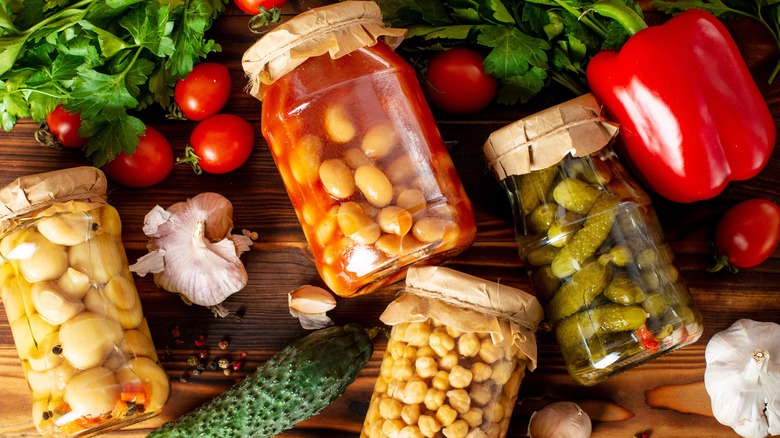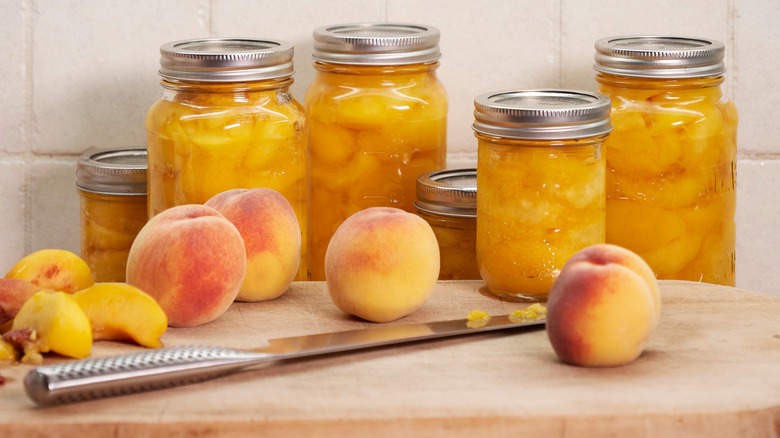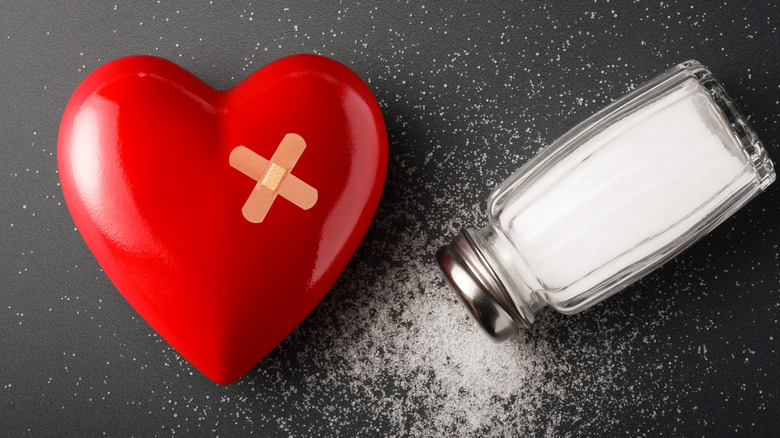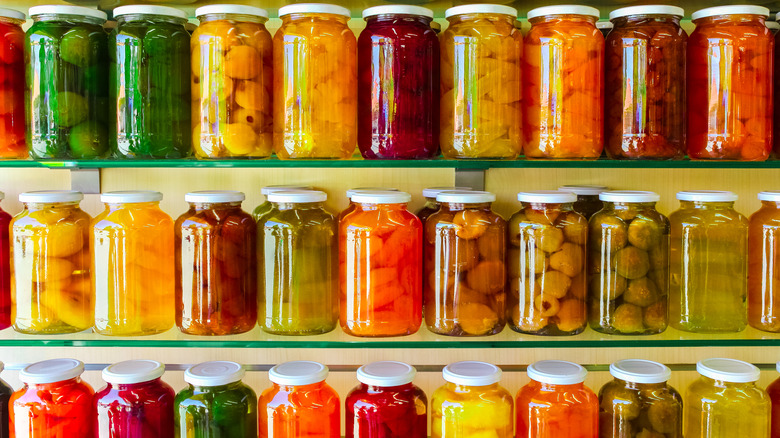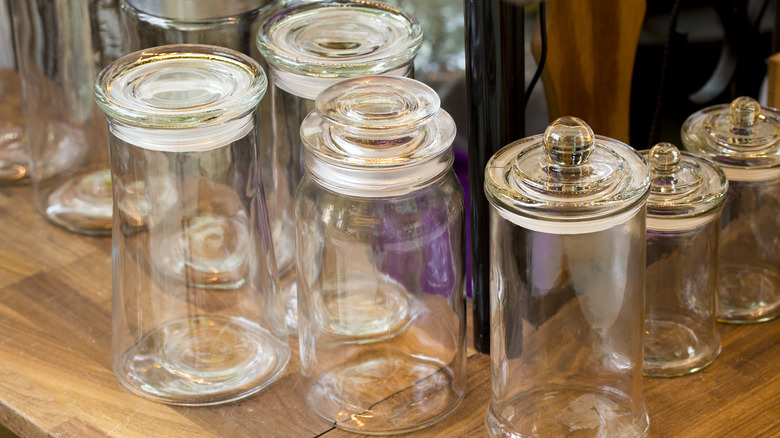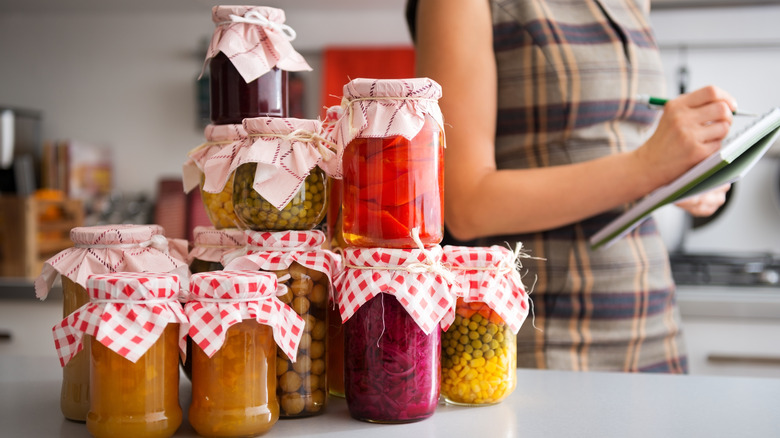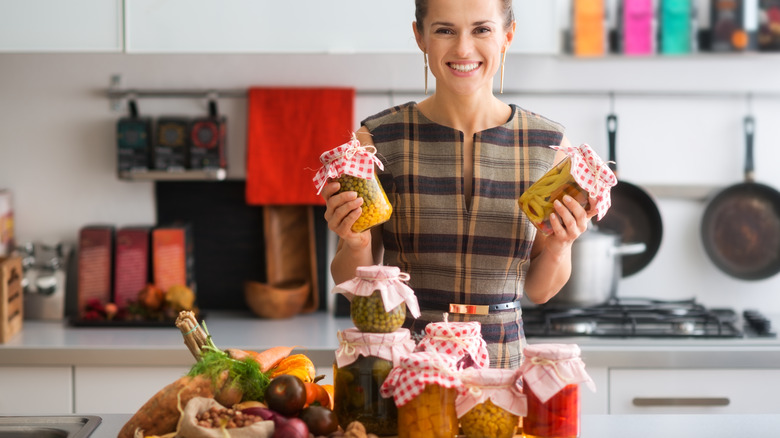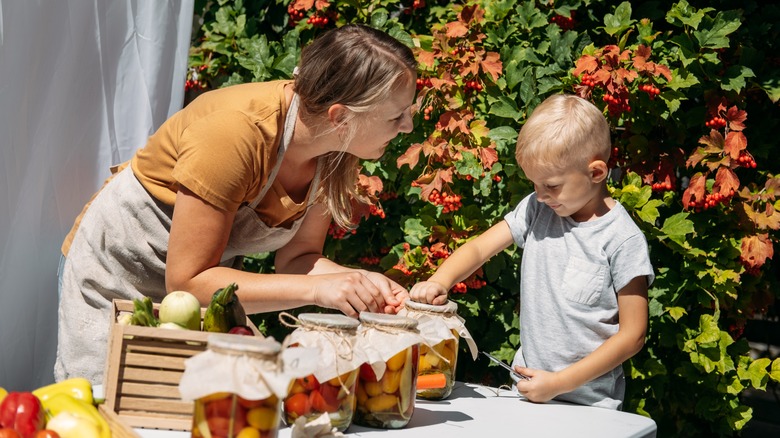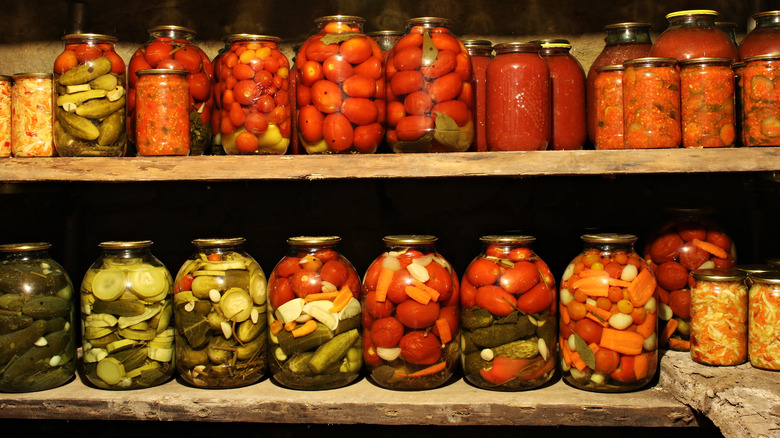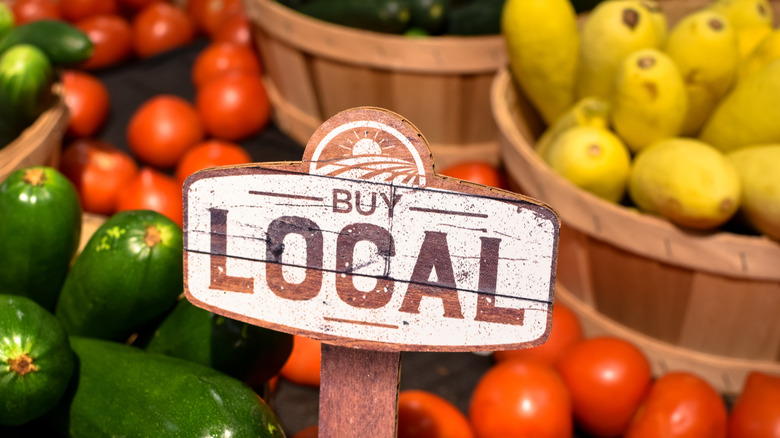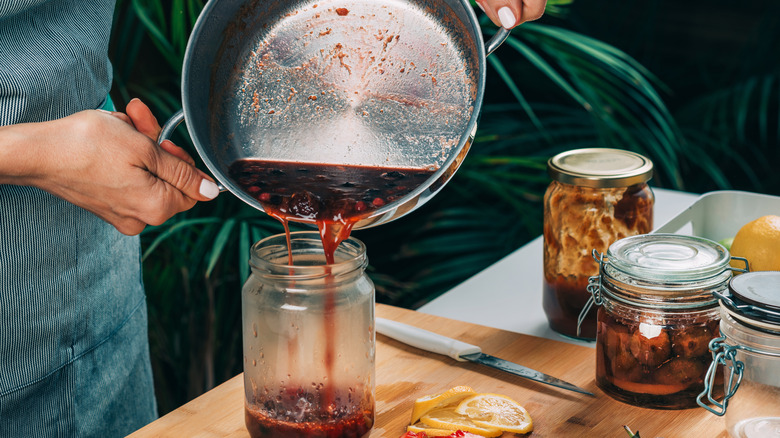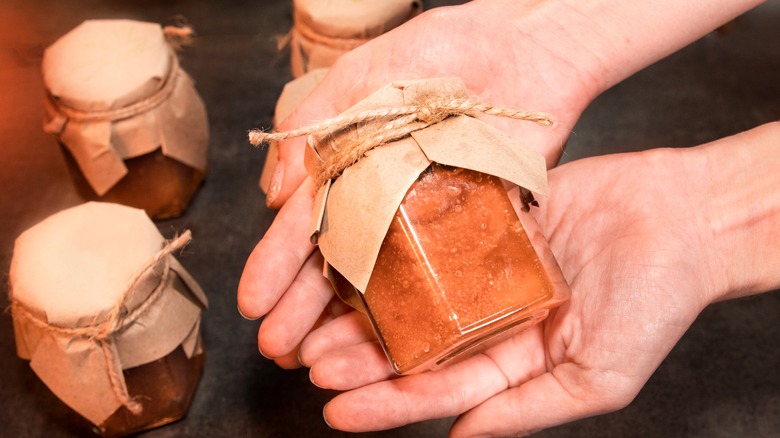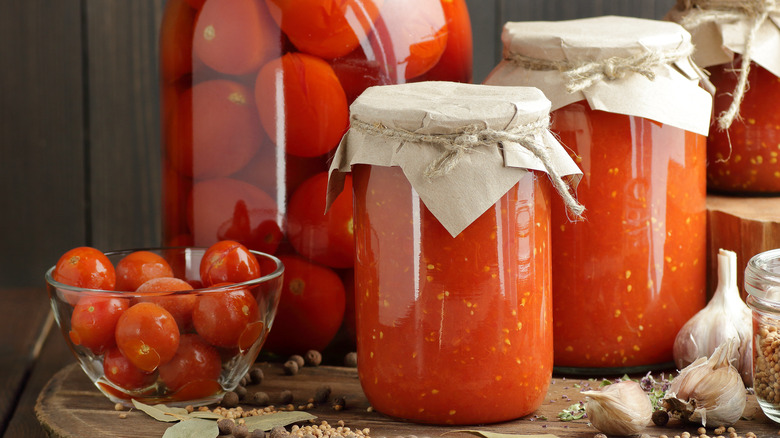12 Benefits Of Canning Your Own Food
Going to the grocery store these days is jarring. Gasp. Did a two-pound loaf of premium bread really spike to $10, as major news outlets like The New York Post reported in July 2022? And it's not just bread. The fruits and vegetables you just put in your cart are up 9.3% over the year, and the milk and dairy on your list are 14.9% higher, according to the most recent data from the U.S. Department of Labor's Consumer Price Index.
With inflation hitting a high of 9.1% this summer, is it any wonder that grocery costs have been eating up family budgets? Not only that, but gloom-and-doom reports from sources like the United Nations and the World Bank abound about the threat of a global food shortage and growing food insecurity, partly triggered by the record-high food prices. For folks looking to cut costs and stay ahead of the game, it's time to get seriously canny and make like the pioneers of old.
In the pioneer days, food was grown off the land and preserved for long, harsh winters. Back then, "putting up the season's harvest" was a way of life. Canning, a time-honored method that uses heat and airtight containers to preserve food, connects us to the past and reminds us of the generations that once gathered in the kitchen for the annual ritual. Regardless of the season, economic climate, or food-shortage hyperbole, canning has so many benefits you'll wonder why you haven't tried it before.
Eating real food
We've all heard the mantra, "Eat well, live longer." Who doesn't strive for that? Michigan State University Extension says while freshly harvested produce is always best, your home-jarred goods can be more nutritious than fresh foods that have traveled long distances to your supermarket. That should make you feel all warm and fuzzy as you savor those luscious, golden peaches you picked, peeled, pitted, and canned in August at your breakfast nook in January. Plus, you won't have to fret about dangerous chemicals like BPA (Bisphenol-A), which coats some metal food cans, according to the National Institute of Environmental Health Sciences.
Further, additives such as citric acid and calcium chloride, though ruled safe, may be found in some products to preserve color and texture, say experts at Kansas State University's Department of Human Nutrition. When it comes to home canning, you are the can-do wizard of your kitchen and have full control over what goes inside each jar. The main thing to keep in mind is to use fruits and vegetables soon after harvest to preserve nutrients, according to Penn State Extension. For most vegetables, the ideal time is within six to 12 hours after picking (via the National Center for Home Food Preservation). Most fruit should be ripened one or more days between harvest and canning. If you can't get to it right away, store items in a cool, dark place until you're ready to tie on the apron and get cooking.
Ditching the salt and sugar
Don't want sugar? Then skip it. After all, experts at the Centers for Disease Control and Prevention say all those extra calories can lead to obesity and chronic illnesses like type 2 diabetes. The beauty is that you can choose to go the sugar-free route, even in your jams and jellies. Make sure to use fully ripe and firm fruits for optimum quality, as the Michigan State University Extension advises. In fact, the agency says that sugar is not needed to prevent spoilage. Keep in mind that if you forgo it in jams and jellies, the product will have a softer texture because sugar helps in the formation of the gel.
If you prefer a sugar substitute, products like Splenda can be used for the syrup that covers the fruit in the jars. Steer clear of saccharin- and aspartame-based sweeteners, which turn bitter when processed. For those looking to limit their sodium intake as a way to avoid health problems like high blood pressure, there is additional good news on the home-canning front. Sodium is optional, even when canning meat and poultry, and not needed for safe processing (via Penn State University Extension. The only exception is brined and cured products like sauerkraut and fermented pickles. They require salt to grow desirable bacteria and prevent the growth of undesirable spoilage bacteria.
Improving your diet
It turns out Mom was right when she scolded you for not finishing your broccoli or that time you turned up your nose to the blackberries she just picked. She knew that fruits and vegetables were packed with the vitamins, minerals, and other nutrients you needed to grow and thrive. In fact, the American Heart Association says eating more fruits and vegetables may help prevent heart disease, cancer, and other illnesses. Plus, they're naturally low in fat and calories and contain no cholesterol, as the U.S. Department of Agriculture notes. Home canning is just what the doctor ordered.
The National Center for Home Food Preservation recommends the book "So Easy to Preserve" by the University of Georgia Cooperative Extension to learn the ins and outs of the process and the best methods to use. Fruit can be canned using a water bath system in which boiling water surrounds the jars, transferring the heat into the jar of food (via Penn State University Extension). Low-acid foods, including most vegetables, require a bit more work with a pressure canner, a sealed unit that, when heated, builds pressure inside and increases the temperature. All the effort is worth it when you survey your big, ready-to-use stock. Ensuring your daily intake of fruits and vegetables has never been as easy as reaching into the pantry.
Protecting the planet
English author and environmental campaigner Tristram Stuart said that cutting food waste is a "delicious way of saving money, helping to feed the world and protect the planet." He might have had home canning in mind as one viable solution. After all, it reduces both food and packaging waste. That is especially so with home-grown food because it doesn't rely on long-distance transportation to get from farm to factory to distributor to the supermarket. In fact, the National Sustainable Agriculture Information Service once reported a study that showed that most processed foods in America travel more than 1,300 miles to get from the farm to your dinner plate, while fresh produce travels 1,500 miles. And this report was in 1997 — well before globalization extended supply chains even further!
Another plus about home canning is that finished goods don't require refrigeration. You can store them in a pantry or basement, and if done right, your pickles, peaches, and pears are shelf-stable for up to a year. When it comes to cutting food waste, canning is the way to go because you're less likely to chuck fruits and vegetables you've taken the time to preserve. According to the Food and Agriculture Organization of the United Nations, global food waste annually amounts to 1.3 billion tons. Conscientious canners know they're doing their part to reduce it. Another plus is that jars are reusable, so you don't have to worry about clogging landfills. It all adds up to good environmental stewardship.
Saving some cash
Seasoned home canners have done their homework regarding buying ingredients in bulk, finding cheap or second-hand supplies, reusing their jars, and even growing their own food. The consensus among these kitchen virtuosos is that canning most definitely saves you money if you stick with it for the long haul. You'll undoubtedly have to invest time and resources to get it off the ground, but there's a reason canning food at home has become widely accessible.
For starters, the North Carolina Extension of Rutherford County says you will need a water bath or pressure canner, mason jars, canning utensils, and gadgets like a water funnel and can lifter. If you're thrifty, you can borrow supplies from friends or relatives or buy them from garage sales, but inspect them first to ensure there aren't any cracks or chips. The real savings can be calculated if you grow the produce yourself. As The Guardian reports, pulling from your own garden is an easy way to cut the cost of fresh foods and the cost of canning and preserving said fruits.
Making dinner a snap
Busy folks need simple solutions, and home canning is one way to solve the after-work conundrum. Now that you're heading home, the question spins in your mind: What's for dinner? Home canners say it's in the jar. After all, they've worked all summer to put up a year's worth of food, so more than half the work is already done.
When fall is on the way, so are busier schedules. But ready-made meals eliminate the hassle of preparation and help you create perfect portions. You can even pressure-can homemade soup, but as the National Center for Home Food Preservation reports, you'll want to make sure to use ingredients that are safe to can — and that you're following specific procedures.
Most modern pressure canners are lightweight, thin-walled kettles with turn-on lids fitted with gaskets, removable racks, vent pipes, and safety fuses. Pressure canners work by trapping steam and building up pressure inside the pot. The high pressure and temperature destroy microorganisms more rapidly, per the University of Wisconsin-Madison. Pressure canning is recommended for low-acid foods like red meats, seafood, poultry, and fresh vegetables (via North Dakota State University Extension). When using a pressure canner, follow tested recipes and full processing times; if done properly, you can enjoy those jarred meals on a busy October day or well into next fall.
Enjoying a meaningful hobby
Is there anything more pleasurable than spreading the ruby-red strawberry jam you made last spring on a scone in the cool of fall? It is intensely personal. It is undeniably delectable. Your hands filled the warm jars with jam. You sealed them for such a morning as this. That's just the thing about canning. It is a hobby that brings a sense of pride and accomplishment when you survey all the jars lined up in your basement pantry. They're like trophies for a job well done. Canning also harkens to the past. Maybe you saw your great-grandmother making a batch of pickled carrots, and the image and smells of summer never left you.
The art of food preservation often is passed down between generations and is a way to connect to simpler times. It feeds the soul and the senses. To boot, it can be done together as a family and used as a learning tool about where food originates. Utah State University reminds us that the more we learn about and become connected to our food supply, the better off we'll be when it comes to strengthening and nourishing our families and communities.
Becoming self-sufficient
Given all that's happening around us — post-pandemic jitters, inflation, and uncertainty about the future — is it any wonder there is renewed interest in canning? Experts at the University of New Hampshire Extension noted the trend in the summer of 2020. Still, the serious uptick began in the early days of the COVID-19 lockdowns, according to Washington State University Insider. Quarantined people started thinking more about access to food, and their pioneering spirits emerged. As noted by Better Homes & Gardens, canning supplies like Ball-branded glass jars and lids were hard to find as people sheltered in place.
The University of Georgia Extension writes that the demand for canning information was so great that virtual webinars began popping up in places like Fulton County, where more than 800 people from seven states and three nations attended the multi-day virtual classes offered by the agency. Food preservation, even post-pandemic, continues to be important in the event of natural disasters, food shortages, life emergencies, convenience, and cost. The value of the so-called "deep pantry," a stash of food, water, and supplies that stretches from two weeks to longer, is important as climate change affects the food supply. Generally speaking, unopened home-canned foods have a shelf life of one year and should be used before two years, says the National Center for Home Food Preservation.
Boosting local farmers
What better joy is there than handing a neighbor a jar of your homemade apple butter as a just-because gift? Those apples came from the orchard outside of town, and the farmer who grew them is grateful for your purchase. Local growers appreciate the business because it helps them remain profitable, especially the smaller operations. That, in turn, boosts the local economy. As we are used to supermarkets that offer everything under the sun, even those who grow and can their own foods often rely on local farmers for bigger bounties that cover essentials that might not be in their garden.
Doing business with farmers you know is comforting because you learn about their growing methods as opposed to chain stores, which often import foods and vegetables from other countries. In some parts of the United States, canners and CSAs (Community Supported Agriculture) have even formed partnerships. An example is FruitBox, a program run by The Green Urban Lunchbox in Salt Lake City, Utah. The way it works is that thrifty canners pick up the not-so-pretty "B-grade" produce grown by urban farmers in training. Such a program is an instance where the term "win-win" applies.
Tapping your creative side
It's okay to think outside the can when it comes to building your pantry. You have a license to go beyond the usual tomato salsas and blueberry preserves and let your mind run free, as long as you follow all the precautions to ensure your food is safe. Experts at the National Center for Home Preservation advise that all preparations should observe current science-based, safe-handling guidelines, such as making sure you sterilize your canning jars. That said, there are many clever ways to add zing to your pantry.
Missing something sweet in the mornings? Try a big batch of our easy strawberry jam recipe, which is good all year round when preserved correctly. If you want something more exciting, making your canned food more flavorful is easier than you think. But before you dive in, get a grasp of the tried-and-true rules for safe canning, as advised by the University of Connecticut Extension. That includes choosing the right canner for the job, buying new jar lids, properly sanitizing, and using freshly picked produce. Additionally, be sure to tap reputable sources such as the National Center for Home Preservation, U.S. Department of Agriculture's Home Canning Division, guides like "Ball Blue Book of Canning and Preserving Recipes," and your local cooperative extension.
Sharing your handmade treasures
When the holidays roll around, it's nice to have a cache of ready-made gifts for the mailman, your child's teacher, your hairstylist, and your coworkers. Let's face it. They probably will get gobs of homemade cookies, so why not give them something extraordinary like a jar of candied jalapeños or a quart of cranberry marmalade? You don't have to wait until the holidays to give away the bounty. Remember that neighbor you gifted with your homemade apple butter? She's already returned the jar — something home canners regard as sacrosanct — and hinting she'd like another.
Since home canning reached its peak in 1943, per the U.S. Department of Agriculture, homemakers, homesteaders, and hobbyists have been sharing their bounty, and it's not just the giveaways that make home canning special. It is very much a social activity that brings families and friends together. If you want a real taste of togetherness, you can even host tomato-canning and jam-making parties. Just lay everything out the night before, gather your harvest, prep the work area, and open the door to welcome your guests. Once they put on their aprons, let the party begin. Everyone will walk away with a smile, an armful of victuals, and lots of memories. Oh, and make sure to include friends who have never canned before. They'll thank you for the new skill.
Anticipating a fruitful journey
Now that you know the countless benefits of canning, what's stopping you from marching to your local hardware store to pick up supplies? You might even be able to find them in good condition at estate sales or in a relative's kitchen. Show your chops as a good student by thoroughly researching the topic and reading step-by-step guides from the National Center for Home Food Preservation, the USDA's National Institute of Food and Agriculture, or your local cooperative extension. Not only will you ensure a safe and efficient process, but you'll also join a community of enthusiasts who are happy to bring new learners along for the ride.
Maybe now's the time to consider growing your own green beans or learning about the best types of tomatoes for canning. With this knowledge, you can stow away your personal stash and take pride in preserving the food you raised yourself. The journey will be especially fruitful (pun intended) if you look at the bigger picture: A plentiful pantry packed with nutritious, quick, and long-lasting bites.
